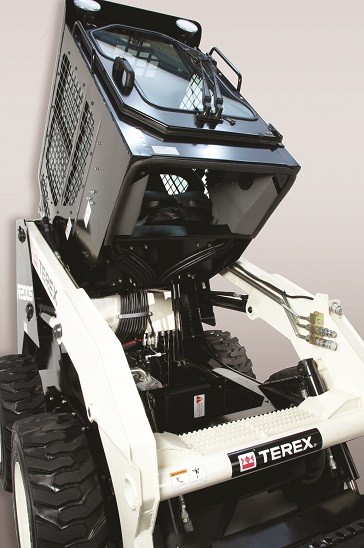
Skid-steer loaders are an indispensable piece of equipment in recycling yards, facilities and compost operations all over North America. The skid steer’s versatility in loading, unloading and material handling, its ability to use a wide range of common hydraulic attachments, combined with its power in lifting and speed in maneuvering make it a key tool in any recycler’s arsenal. Following are some key considerations when it comes to maintaining skid steers, from Terex – for anyone who depends on their skid steer loader every day to get the job done.
According to Jonathon Ferguson, Terex regional sales manager, “Owners and operators need to see the value of a preventive maintenance program, or they won’t do it. It is easier to deal with things little by little rather than have something fail and face the consequences: costly repairs and expensive downtime.”
A skid-steer loader maintenance routine should be based on the number of hours on the machine. Daily, or about every eight hours of work, skid steers need to be visually inspected by the operator. Every two to three months (approximately 250 working hours), biannually (500 hours) and annually (1,000 hours), a machine should be taken into the shop to be inspected and serviced by a trained technician.
“A lot of unexpected problems can be caught or prevented if a skid-steer loader operator simply takes 15 minutes before start-up each day to check the fluids and general condition of the machine,” says Ferguson.
Importance of tires
Tires are one of the most important components to inspect daily on a skid-steer loader, advises Ferguson. “Tires need to be checked frequently for tread depth, wear, damage and pressure. Keep tires properly inflated at all times to ensure machine stability for safe and efficient operation.”
Because skid steers have no frame suspension to soften the ride for the operator, the air in the tires provides the only cushion between the loader and the ground. Proper tire pressure and balance is critical for stability and durability of a loader. Under-inflated tires can decrease the overall stability of a unit. One noticeable characteristic of this is that a loader that is operating with under-inflated tires will tend to bounce more when going over rough terrain. Over-inflated tires are stiff and unyielding, giving the operator a harsher ride and making the tires more susceptible to damage. Also, make sure that all four tires are evenly inflated. “If the tire pressure from wheel to wheel varies greatly, the whole unit can become less stable due to uneven compression,” says Ferguson.
He also notes that tires should be inflated to the maximum pressure indicated on the sidewall of the tire. Rims should also be inspected for dents, rust, cracks and scrapes, and replaced as necessary. “A blowout or rim failure can lead to more serious consequences.”
At the end of each day, while a skid-steer loader is still warm, it is important to wash down the unit – removing any materials that accumulate in the chassis and engine compartment and which could contaminate the machine. Operators can use a shop-vac to remove any water and debris in the hard-to-reach areas, and they should use a pressure washer or compressed air nozzle to blow debris out of the radiator and oil cooler. In addition, operators need to drain the water separator, which removes water from the fuel supply as the engine runs.
“The end of the day is also the time that operators should report the hours on the unit, as well as how it is being used during the day – including what kind of materials it is handling and how far the materials are being transported – to the fleet manager,” says Ferguson.
Considerations for Tier 4 engines
Today’s new skid-steer loaders equipped with Tier 4 engine technology need to be maintained daily according to the engine manufacturer’s recommended guidelines. Lower combustion temperatures in Tier 4 engines reduce NOX but result in an increase in particulate matter. Terex skid-steer loaders, for example, are equipped with EGR engines and DPF exhaust systems.
All EGR engines with DPF exhaust systems capture soot until they fill up and create too much back-pressure. At that point, the DPFs use one of two approaches to regenerate (clean) themselves: passive and active.
Passive regenerating cycles usually happen without the operator knowing about it. The vehicle’s duty cycles, temperature and pressure output at the DPF initiates this cycle by changing the fuel to air mixture during the combustion cycle to increase the temperature across the DPF, causing a minor burn off of the DPF.
Active regeneration cycles give indicators to the operator through an operator interface to make the driver aware that the unit is about to undergo an active regeneration cycle. At this time, the operator should inspect the DPF area for contaminants before the active regeneration occurs.
“Skid-steer loaders,” says Ferguson, “most often generate enough heat to clear the DPF through passive regeneration.
“Although more sensitive to duty cycle and temperature, once installed, these DPF systems are considered to be more user friendly, as they do not require fuel additives, have no moving components and only need to be serviced for annual cleaning.”
Regular reviews and long-term maintenance
Longer-term maintenance tasks must also be a priority, advises Ferguson. “The number one reason for machine failure is negligence of the preventive maintenance tasks. Keeping up with fluid and filter changes, as well as chain tensioning, are crucial to long-lasting productivity. Also, it is important to regularly review manufacturer product and service bulletins and to make the necessary updates, based on the unit’s serial number, as recommended.”
Regular oil changes are necessary to maintain a strong running engine. At the 250-hour mark, the engine oil and filter should be replaced. It is important to check the manufacturer’s recommended guidelines for engine oil specifications. For example, Terex recommends a heavyduty engine oil for most conditions. Engine oil substitutes may be used as long as the oil meets the manufacturer’s minimum specifications.
Hydraulic fluid filters should also be replaced after 250 working hours on the machine. The fuel filter, which removes contaminants from the fuel as it enters the engine, should be changed at least every 500 hours to prevent plugging and loss of engine power. The hydraulic oil and radiator coolant should be changed every 1,000 operating hours.
According to Ferguson, proper chain tension should always be maintained to minimize wear and prevent damage to the skid-steer loader’s drive system. The chain tension should be checked every 500 hours and adjusted as necessary, and chain case oil should be changed every 1,000 hours to maintain proper lubrication and minimize component wear.
To keep a skid-steer loader running at peak efficiency, Ferguson says investing in a preventive maintenance program is undoubtedly money well spent. His last piece of advice: “Maintain a regular maintenance schedule and follow the manufacturer’s prescribed action items to keep a skid-steer loader up and running for a long time.”



